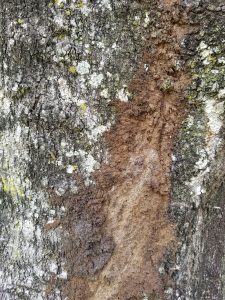
As Floridians begin to work on recovery efforts from the destruction caused by hurricanes Debby, Helene and Milton, many are dealing with fallen trees that

have damaged their property. For some, the situation is even worse due to an unexpected culprit: termites.
According to Thomas Chouvenc, associate professor of urban entomology at the UF/IFAS Fort Lauderdale Research and Education Center, homeowners need to be vigilant about fallen trees now more than ever, some of which may have already been damaged by termites before the storms hit. Fallen trees with unusual damage can also reveal the presence of invasive subterranean termites within the surrounding areas of a home.
“This hurricane season in Florida has proven to be more challenging than in years past, with intense wind speed and floods. Unfortunately, Florida is also facing mounting termite pressure with the spread of major invasive pest species in many urban areas across the state,” he said. “While hurricanes pose a direct threat to trees and structures, the hidden damage caused by invasive termites can make the situation worse.”
Trees that have been compromised by termites may appear healthy, but their internal structure could be weakened, making them more vulnerable to storm damage, he said.
The Formosan subterranean termite and the Asian subterranean termite, two invasive species, have become entrenched in some of Florida’s urban areas. These pests not only infest buildings but also silently consume live trees from the inside, often with minimal visible signs of infestation. Chouvenc warns that trees weakened by termites are more likely to fall during storms, even when wind speeds would normally not be enough to cause the damage.
“After a storm, we often see trees on roofs and cars, but many of these trees would have withstood the storm had they not been compromised by termites,” said Chouvenc “In areas where these two invasive termites have established for years, it is essential to inspect trees regularly for termite mud tubes. Detecting infestations early can save both the tree and prevent potential storm damage.”

Florida’s unique blend of tropical storms and invasive termites creates a perfect storm of risk. Invasive termite species continue to spread across the state, threatening both homes and historical urban tree canopies.
Chouvenc emphasizes the importance for Florida homeowners and communities in to be aware of the species present in their neighborhoods by being proactive about managing termite risks, particularly as the state continues to face mounting pressures from both storms and invasive pest species. In areas at risk, having trees regularly inspected by certified pest control providers can allow for early detection of a termite infestation, and elimination of infesting colonies, to save the tree from extensive damage and save properties from future destruction due to weakened trees.
“Regular tree inspections can help detect early termite infestations, allowing for treatment before the damage becomes extensive. This can save both the tree and the property it protects,” he said.
UF/IFAS offers a valuable resource for homeowners to assess the termite threat in their area. The UF/IFAS termite distribution map provides up-to-date information on where the primary invasive termite pest species are located across the state. Residents are encouraged to check the map to determine their risk and take necessary precautions, including inspecting and treating trees in their yards.
“The spread of invasive termite species will continue to be a challenge for Florida’s urban ecosystems, particularly as we experience more intense storm seasons,” Chouvenc said. “By addressing termite infestations, we can strengthen our tree canopy, making it more resilient against future hurricanes and safeguarding our homes and communities.”
###
By Lourdes Mederos, rodriguezl@ufl.edu
Para accesar a este contenido en español, por favor utilice este enlace.
ABOUT UF/IFAS
The mission of the University of Florida Institute of Food and Agricultural Sciences (UF/IFAS) is to develop knowledge relevant to agricultural, human and natural resources and to make that knowledge available to sustain and enhance the quality of human life. With more than a dozen research facilities, 67 county Extension offices, and award-winning students and faculty in the UF College of Agricultural and Life Sciences, UF/IFAS brings science-based solutions to the state’s agricultural and natural resources industries, and all Florida residents.
 0
0
